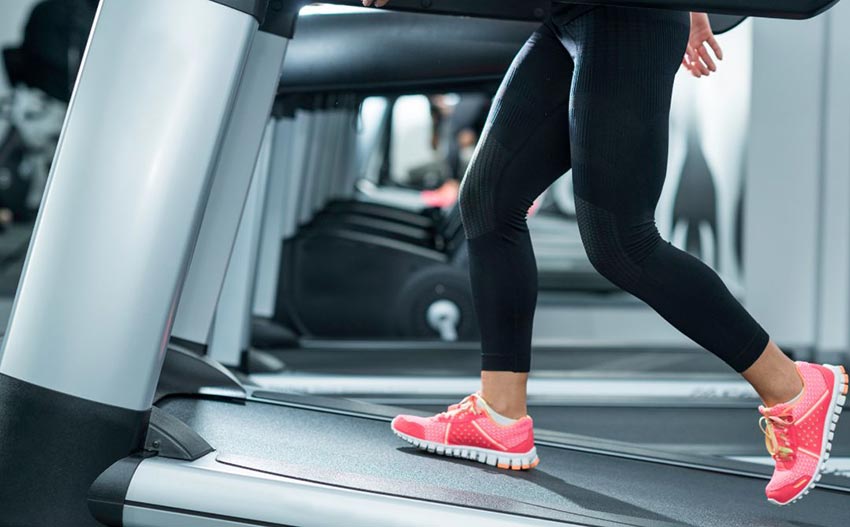Incline walking is one of the most recommended cardio exercises if you’re trying to lose weight, burn calories, and lower your body fat. But does incline walking build muscles?
If you tried setting up the incline on a treadmill to do some incline walking, you must’ve noticed how your calves get fired up and feel heavy after a while. Does this mean that you’re building muscles while burning calories at the same time?
Down below, we’ll show you how incline walking benefits your body, but also 12 benefits of incline walking you should be aware of, so keep on reading!
Does Incline Walking Build Muscle?
Incline walking does help you build lean muscle while you’re walking on a treadmill. At the same time, while you’re doing cardio, you’re helping your body burn more fat efficiently. What many people don’t know is that a treadmill is also a great way to rehabilitate any weaknesses or lower body injuries.
An inclined treadmill helps you walk in a safe and controlled way that benefits your muscles, and joints and helps improve overall body health. Incline walking is one of the most recommended exercises for weight lifters too, and here are benefits that prove why.
12 Benefits of Incline Walking
1. Increased Calorie Burn
The biggest benefit of incline walking is the increased calorie burn. Setting a treadmill to an incline gives better benefits than when walking on a flat treadmill. Just a 1% incline can help burn 12% more calories, compared to walking on a level ground.
If you don’t have a gym nearby or a treadmill at home, or if you prefer walking in the fresh air, finding hilly areas is the best way to experience an increased calorie burn.
2. Muscle Engagement
Walking uphill targets more muscles in the legs and body, including the glutes and core. This helps activate more upper and lower muscles than walking on a level ground. Even though it’s a demanding activity, it will help improve endurance and overall strength much faster than any other type of walking.

3. Low Impact
Even though it can feel like walking on an incline is very hard on your knees, it’s not and it’s a low-impact workout that puts less stress on your joints than other similar exercises. Running and jogging put a lot more stress on the joints and body, which makes incline walking ideal for everyone who has joint issues or is recovering from an injury.
Being a low-impact exercise too, it’s also great for all fitness levels, so you don’t have to have a high stamina or strength to gain the benefits of walking on an incline.
4. Posture Improvement
This benefit is often overlooked, but the truth is that incline walking can help engage core muscles, which are the type of muscles that have an impact on posture. With a positive impact of incline walking, this can help improve posture over time. Even though it takes time, it’s one of the additional benefits you can forget about at first, but then notice the results after a while.
With posture improvement, incline walking also indirectly helps counteract sudden forces and boosts athletic performance as a result.
5. Cardiovascular Health
Incline walking increases the heart rate as it requires more energy so it burns more calories while activating many muscles. Walking with an increased heart rate helps strengthen the heart and it improves cardiovascular fitness, which is great considering you’re still walking and aren’t relying on any other form of cardio.
Starting slow and letting your ability take you to the maximum incline on a treadmill or in the nature you can handle will improve your cardiovascular health over time.
6. Bone Health
The great thing about incline walking is that it’s considered a weighted exercise since it feels like a weighted exercise compared to walking on level ground. That being said, walking on an inclined terrain can help you strengthen bones, which helps reduce the risk of osteoporosis.
When walking up the hill, the body withstands the gravity in new ways it’s usually not doing, which doesn’t only have benefits to muscles and tissue, but bones as well.
7. Endorphin Boost
Another way to prove that incline walking is an exercise is to understand that you will experience similar mental effects as you would when you’re performing any other exercise. For example, like any other form of exercise, incline walking can help release endorphins, which help reduce stress levels, improve mood, and help you feel good with such chemical release within your body.
As you exercise more regularly, you’ll gain the ability to handle steeper inclines, which will also help you release more endorphins within your body after making progress and achieving something you usually couldn’t.
8. Increased Intensity
Walking on the hill puts your cardiovascular system to the test, which is a considerably higher intensity than walking on level ground. With the earlier-mentioned boost to cardiovascular health, you also gain better stamina and overall fitness.
Not only can incline walking help you lose weight, but it can also help you get in shape and make walks that were once difficult a breeze.
9. Strength Gain
Whether you’re inclined to walk on a treadmill or in a hilly area, your body relies on regular walking mechanics, which helps improve functional strength when performed on an incline. Functional strength helps you gain benefits in mobility, which makes daily activities easier and much more accessible, especially if they’re outdoor-type activities.
Besides strengthening your legs, you’ll also strengthen your cardiovascular fitness, which makes a great way to burn calories, get in shape, lose weight, and even get leaner.
10. Weight Loss
Since incline walking touches so many areas of a human’s body, all of these combined have a positive impact on weight loss progress. If you’re trying to lose weight, regular incline walking in combination with a decent and balanced diet can lead to great weight loss.

Of course, you should ensure you burn the most calories you can during the incline walks but also measure your calorie intake. The great thing about incline walking is that it can increase metabolism over time, which also helps make weight loss easier and faster for certain individuals.
11. Variety
The thing about incline walking is that it’s never the same. If you do it outdoors, you can find a variety of hills, where each incline is different, making your exercise interesting, but also challenging. Making progress and finding steeper hills is a great way to progress and gain even more benefits from incline walking.
If you rely on a treadmill, you can set your incline manually where you can create a workout routine that makes it interesting but also very challenging on certain days.
12. Accessibility
The last benefit is accessibility, which means that you only need a quality, comfortable pair of shoes to start your incline walking journey. Some prefer to do it in the gym on a treadmill, or even at home using a treadmill, which is also great. However, there’s nothing better than fresh air, finding hills in your local area, and going out for an adventure that’s also very beneficial for your body.
Drawbacks of Incline Walking
With so many benefits of incline walking, there are also a few drawbacks you should be aware of.
There’s a potential for overuse of certain muscles, which can lead to an injury. Since there’s less dynamic movement, incline walking might not be a good fit for everyone’s liking. While incline walking works a certain group of muscles, overusing these muscles and only relying on an incline walk as an exercise can lead to a muscle imbalance.
Lastly, there’s always a risk of slips and falls, which can lead to additional injuries that can prevent you from exercising for a while.
Conclusion
So if you’re still wondering if incline walking builds muscle, the answer is yes! Incline walking is great at building muscles, burning calories, and improving overall stamina, strengthening bones, and increasing stamina.
The only thing you have to be careful about is muscle imbalance, which can happen if you only rely on incline walking as an exercise. Therefore, it’s best to combine incline walking with any other exercise of your liking, which will also help ensure incline walking doesn’t become boring after a while.
FAQs
Will walking incline bulk up legs?
Yes, walking incline will bulk up legs as incline walks rely on bigger muscles, but also target more than one muscle group at a time.
Is incline better for muscle growth?
Yes, an incline is much better for muscle growth than a level ground, as it uses more muscles and relies on more muscle groups for the exercise while increasing the intensity.
What does walking on an incline do to your body?
Walking on an incline helps increase the intensity, improve stamina, use more muscles, grow muscles, burn calories, improve mobility, and eventually help a person get fitter.
Can you get toned from incline walking?
Yes, you can get toned from incline walking, and we highly recommend ensuring your diet is in check to do so.
Will walking on an incline slim my thighs?
Walking on an incline can slim your thighs by helping you reduce body fat, but it’ll also help your quad muscles grow, so you’ll get leaner with more muscles.
Is it better to walk longer or on an incline?
Walking on an incline is better because you can achieve higher intensity in a shorter amount of time, so you don’t have to walk for so long to reach better results.
Is it better to walk faster or higher inclines?
It’s better to do higher inclines as this will increase the intensity, which leads to gaining much better results quicker than if you walked faster on level ground.
Does walking on inclines build calves?
Yes, walking on an incline builds calves.
Does walking on an incline help cellulite?
Yes, walking on an incline can help a person lose body fat, eliminating cellulite.





